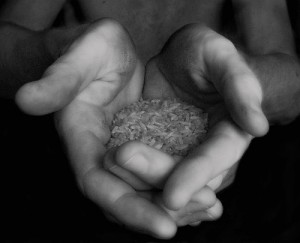Hispanic Children Twice As Likely To Be At Risk Of Hunger
 By Voxxi
By Voxxi
More than 48 million people in the United States live in food insecure households, and Hispanicsare twice as likely to live at risk of hunger, compared to non-Hispanic whites, according to numbers released by Feeding America.
Serving approximately 6 million people in the United States every week, Feeding America’s programs help those dealing with “food insecurity,” a term introduced by the United States Department of Agriculture to describe a lack of access to high-quality foods, disrupted eating patterns, and reduced food intake.
According to Map the Meal Gap, a compilation of data from 61,000 food banks, shelters and soup kitchens, 29 percent (1 in 3) Hispanic children live in households in need of Feeding America’s services, compared to 11 percent (1 in 9) children from non-Hispanic white households.
No county in the United States is free from food insecurity, according to the Map the Meal Gap study.
Some of the states with higher rates of food insecurity have higher concentrations of Hispanic households. Texas, Arizona, Arkansas, Georgia, Florida and California have some of the highest rates in food insecurity for children under 18. Overall, more than 20 percent of children in 40 states live in food insecure households, which means there is high uncertainty where the next meal is going to come from.
According to Feeding America and the Department of Agriculture:
- In 2010, more than 17 million households in the U.S. faced food insecurity and 6.4 million dealt with low food security.
- In 2010, households that ranked higher in food insecurity were headed by single mothers (35.1 percent) and Hispanics (26.2 percent). Close behind were households with single men (25.4 percent) and black non-Hispanics (25.1 percent).
- Hispanics are 1.2 times more likely to be obese than non-Hispanic whites because of poor quality diets, and subsequently both Latino men and women have higher risks of diabetes than other ethnic groups.
- Unemployment, and not poverty, better predicts food insecurity in a community. Eleven percent of Latinos are unemployed compared to 8 percent of non-Hispanic whites.
Food insecurity offers especially serious health risks to Hispanics – a group with the lowest health insurance rates in the nation.
According to Mother and Child Nutrition, the effects of chronic malnutrition in children are often irreversible, and the condition is the largest contributor to high mortality rates in children under the age of 5. Malnutrition can lead to stunted growth, cognitive impairment, and a decline of the body’s immune system, making children susceptible to infection and disease.
Malnourished children are also more likely to have low IQ’s, higher rates of school absenteeism, and lower physical and motor development.
According to the Department of Agriculture’s Food and Nutrition Services, Hispanics are less likely to participate in the Supplemental Nutrition Assistance Program (SNAP), government coupons developed to assist individuals with the purchase ofcertain fundamental groceries. Hispanics represent more than one-quarter of eligible households that do not participatein the program.
Latino seniors are also at higher risk of malnutrition and related health complications, becausethey are less likely to seek aid due to cultural barriers, functional limitation, lack of transportation and lack of information about available services.
According to Mayo Clinic, malnourished seniors often experience:
- Sarcopenia, the progressive loss of lean body mass.
- Poor wound healing due to inadequate protein, carbohydrates and minerals.
- Muscle weakness, which can lead to falls and fractures.
- Cachexia, severe weight loss characterized by protruding bones, dry skin, loss of hair, and increased risk of ulcers and hip fractures.
- Malnutrition-induced liver, kidney or heart failure.
- Increased risk of pneumonia, sepsis, urinary tract infections, and gastroenteritis.
This article first appeared on Voxxi.
[Photo by Mr. Kris]
